Comprehensive Business and Environment Analysis Report for Tesco
VerifiedAdded on 2023/01/13
|19
|7001
|58
Report
AI Summary
This report provides a comprehensive analysis of Tesco's business environment, exploring various aspects such as organizational types (public, private, and voluntary), their purposes, and the scope of their operations. It delves into the internal and external factors influencing Tesco, employing PESTEL and SWOT analyses to assess macro-environmental influences and identify strengths and weaknesses. The report also examines the interrelation between different organizational functions like human resources, finance, and marketing within Tesco. Furthermore, it discusses the positive and negative impacts of macro-environmental factors on Tesco, offering a detailed understanding of the company's position within the dynamic UK retail market and globally.
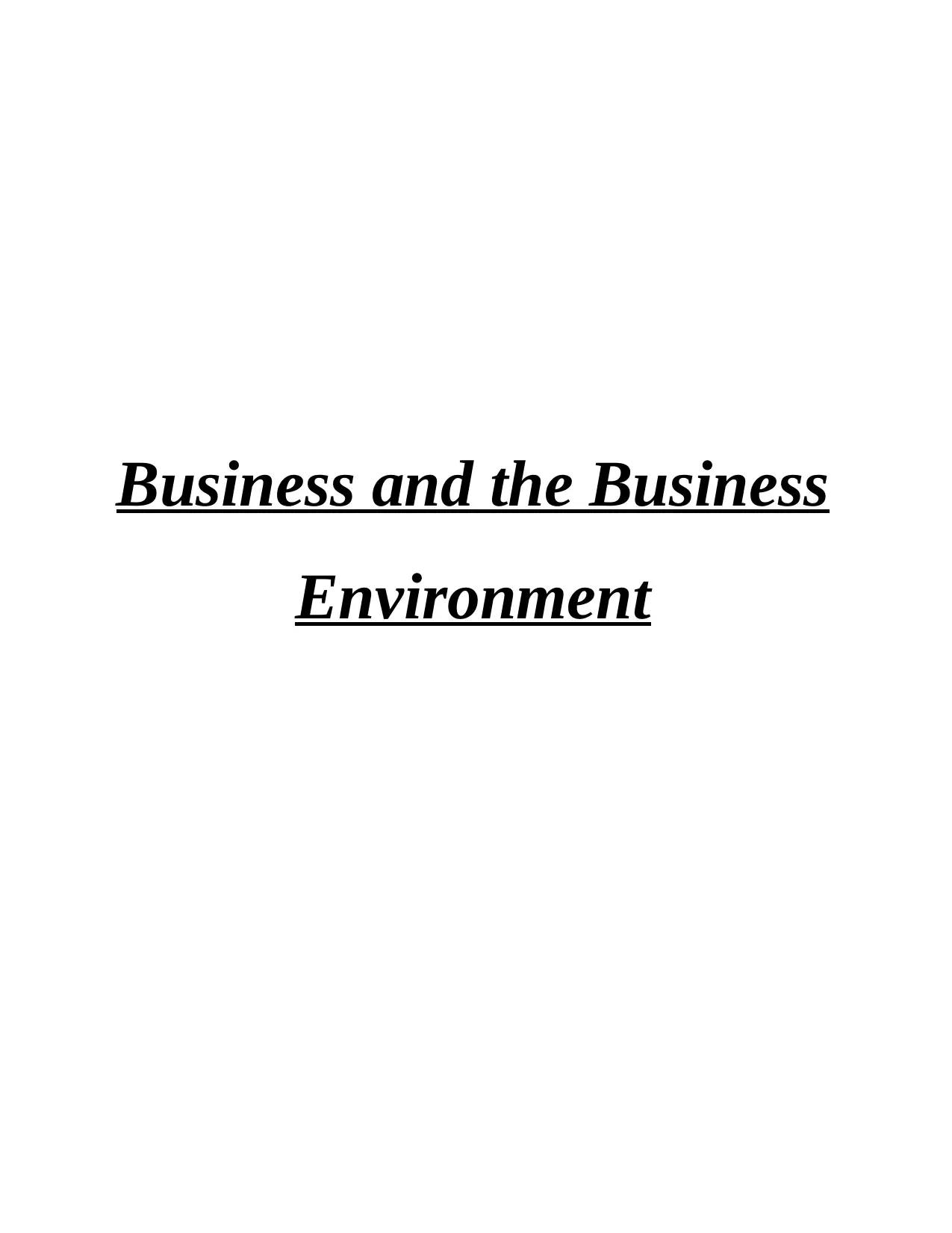
Business and the Business
Environment
Environment
Paraphrase This Document
Need a fresh take? Get an instant paraphrase of this document with our AI Paraphraser
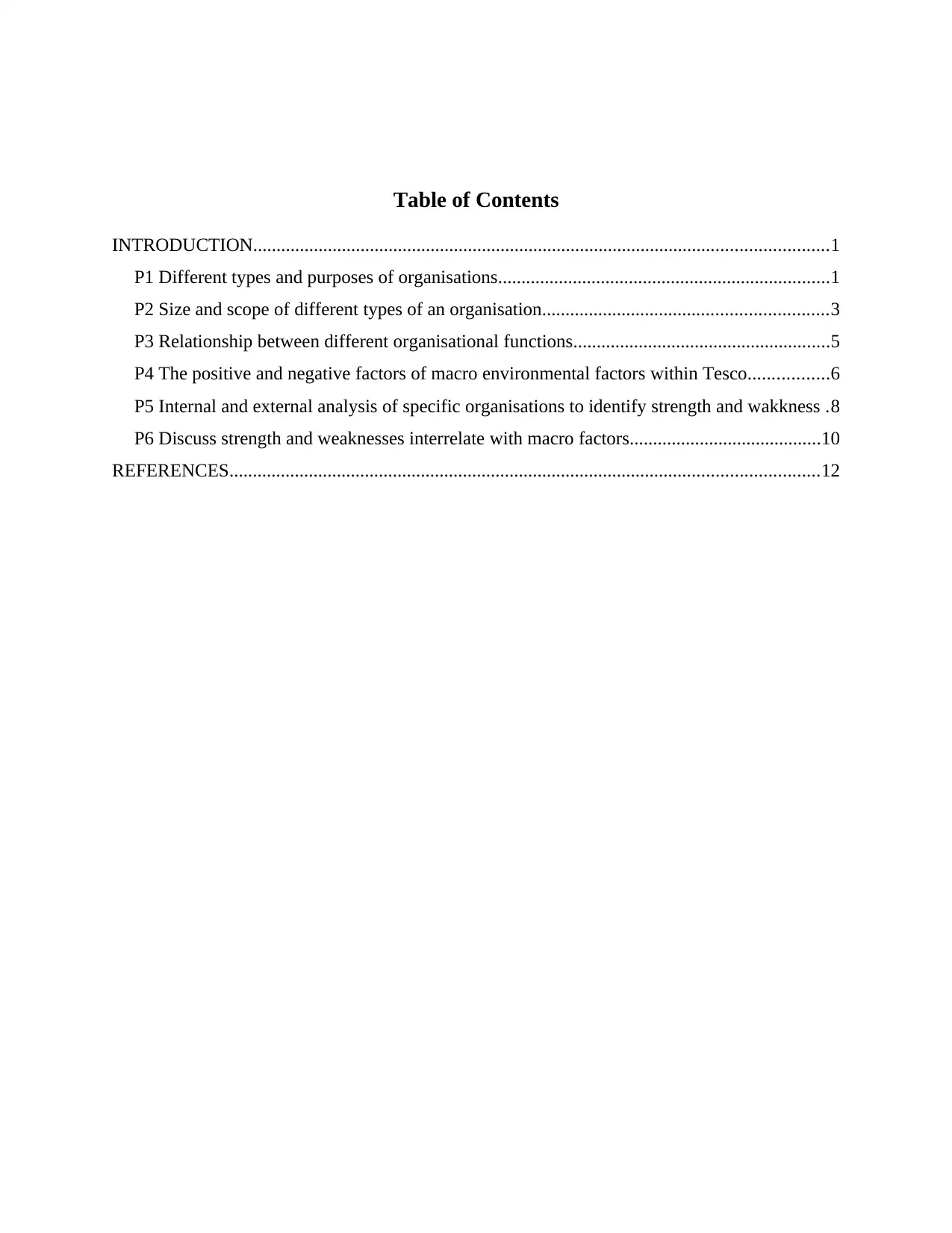
Table of Contents
INTRODUCTION...........................................................................................................................1
P1 Different types and purposes of organisations.......................................................................1
P2 Size and scope of different types of an organisation.............................................................3
P3 Relationship between different organisational functions.......................................................5
P4 The positive and negative factors of macro environmental factors within Tesco.................6
P5 Internal and external analysis of specific organisations to identify strength and wakkness .8
P6 Discuss strength and weaknesses interrelate with macro factors.........................................10
REFERENCES..............................................................................................................................12
INTRODUCTION...........................................................................................................................1
P1 Different types and purposes of organisations.......................................................................1
P2 Size and scope of different types of an organisation.............................................................3
P3 Relationship between different organisational functions.......................................................5
P4 The positive and negative factors of macro environmental factors within Tesco.................6
P5 Internal and external analysis of specific organisations to identify strength and wakkness .8
P6 Discuss strength and weaknesses interrelate with macro factors.........................................10
REFERENCES..............................................................................................................................12

INTRODUCTION
Business environment consist of sum of both internal and external factors that includes
various aspects such as level of competition, employment, demand and supply, suppliers, client,
management, market trends and so on (Quinlan and et. al., 2019). The business environment is
dynamic and the manager has to adopt the changes in policies, procedures, rules and regulation
of the company so as to gain a significant position within the market. Tesco is one of the leading
retailers in UK that deal with large variety of products such as groceries, toys, furniture and
variety of financial services across the globe. Tesco is a renowned brand and is the third largest
retailer in the world that meet the needs of individuals. This report is based on different types and
purposes of an organisations such as public, private and voluntary. This report also covers the
PESTEL AND SWOT analysis to assess the changes of internal and external analysis within the
organisation. The interrelation between various departments is also covered in a report in various
aspects like human resources, finance, marketing and so on as each department perform different
functions and responsibilities
P1 Different types and purposes of organisations
Organisation comprises of group of people who work together for accomplishment of a
common task. The manager performs various functions such as planning, organising, directing
and monitoring the activities to facilitate the smooth operation of a business enterprise. The
organisation helps in dividing the work among the subordinates in according to their specialised
skills so that they work with greater efficiency and contribute to the success and prosperity in a
workforce. There are different types of organisation such as private, public and voluntary which
are describes as follows:
Public organisation: These are the organisation that are owned and operated by the
government and the tax that are collected from the large number of individuals are used for
important projects like public parks, water supply, roads, railways and other infrastructure for
the development of the country(Gaganis, Pasiouras, and Voulgari, 2019). Public limited
companies have huge financial resources and their liability is limited to the extent of capital
contributed by them. The public companies often takes a enough amount of shares in the capital
investment form people and it does also makes them partners in the profits as well as inn losses
of the organisation. The effective system of BBC organisation and its working transparency
1
Business environment consist of sum of both internal and external factors that includes
various aspects such as level of competition, employment, demand and supply, suppliers, client,
management, market trends and so on (Quinlan and et. al., 2019). The business environment is
dynamic and the manager has to adopt the changes in policies, procedures, rules and regulation
of the company so as to gain a significant position within the market. Tesco is one of the leading
retailers in UK that deal with large variety of products such as groceries, toys, furniture and
variety of financial services across the globe. Tesco is a renowned brand and is the third largest
retailer in the world that meet the needs of individuals. This report is based on different types and
purposes of an organisations such as public, private and voluntary. This report also covers the
PESTEL AND SWOT analysis to assess the changes of internal and external analysis within the
organisation. The interrelation between various departments is also covered in a report in various
aspects like human resources, finance, marketing and so on as each department perform different
functions and responsibilities
P1 Different types and purposes of organisations
Organisation comprises of group of people who work together for accomplishment of a
common task. The manager performs various functions such as planning, organising, directing
and monitoring the activities to facilitate the smooth operation of a business enterprise. The
organisation helps in dividing the work among the subordinates in according to their specialised
skills so that they work with greater efficiency and contribute to the success and prosperity in a
workforce. There are different types of organisation such as private, public and voluntary which
are describes as follows:
Public organisation: These are the organisation that are owned and operated by the
government and the tax that are collected from the large number of individuals are used for
important projects like public parks, water supply, roads, railways and other infrastructure for
the development of the country(Gaganis, Pasiouras, and Voulgari, 2019). Public limited
companies have huge financial resources and their liability is limited to the extent of capital
contributed by them. The public companies often takes a enough amount of shares in the capital
investment form people and it does also makes them partners in the profits as well as inn losses
of the organisation. The effective system of BBC organisation and its working transparency
1
⊘ This is a preview!⊘
Do you want full access?
Subscribe today to unlock all pages.

Trusted by 1+ million students worldwide
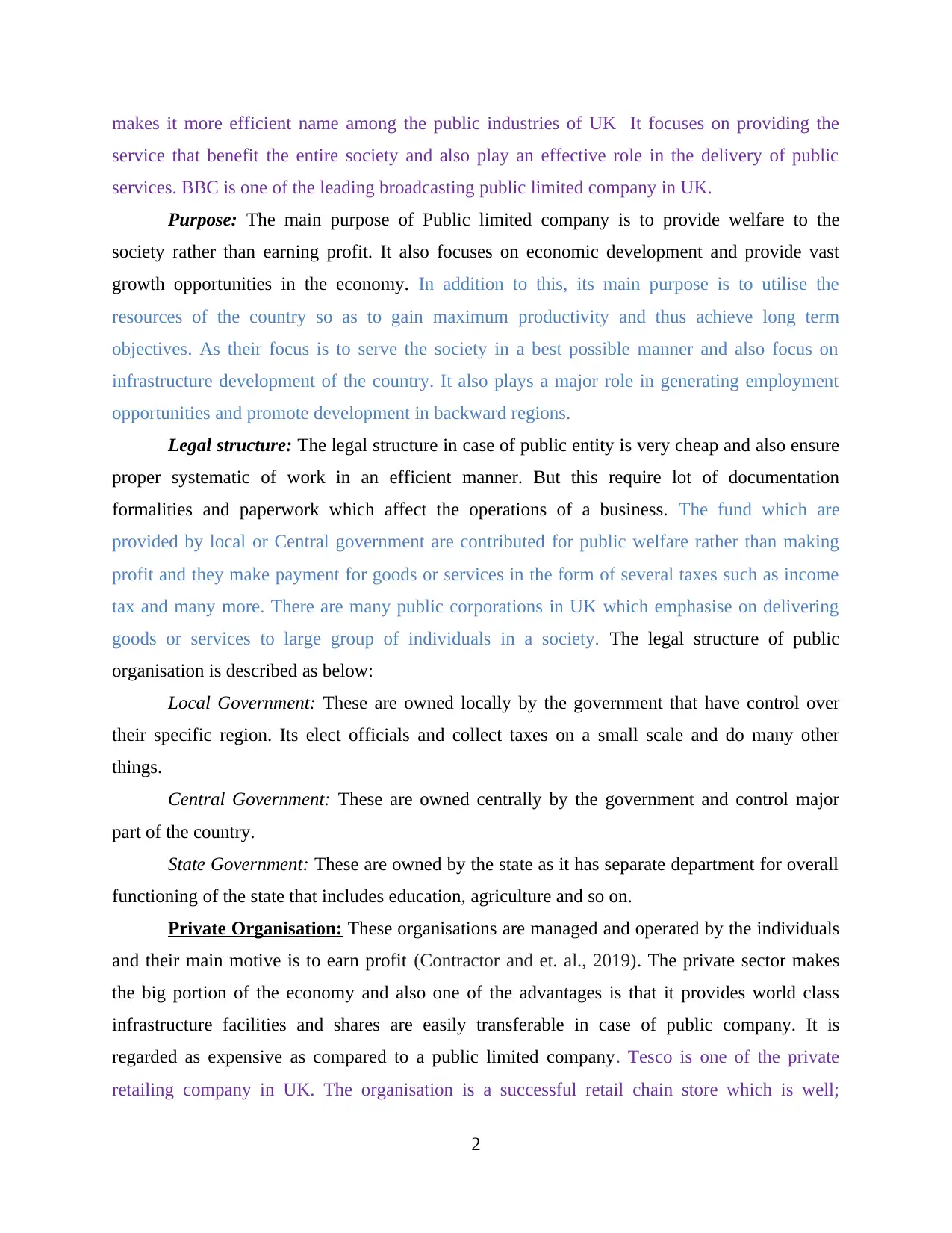
makes it more efficient name among the public industries of UK It focuses on providing the
service that benefit the entire society and also play an effective role in the delivery of public
services. BBC is one of the leading broadcasting public limited company in UK.
Purpose: The main purpose of Public limited company is to provide welfare to the
society rather than earning profit. It also focuses on economic development and provide vast
growth opportunities in the economy. In addition to this, its main purpose is to utilise the
resources of the country so as to gain maximum productivity and thus achieve long term
objectives. As their focus is to serve the society in a best possible manner and also focus on
infrastructure development of the country. It also plays a major role in generating employment
opportunities and promote development in backward regions.
Legal structure: The legal structure in case of public entity is very cheap and also ensure
proper systematic of work in an efficient manner. But this require lot of documentation
formalities and paperwork which affect the operations of a business. The fund which are
provided by local or Central government are contributed for public welfare rather than making
profit and they make payment for goods or services in the form of several taxes such as income
tax and many more. There are many public corporations in UK which emphasise on delivering
goods or services to large group of individuals in a society. The legal structure of public
organisation is described as below:
Local Government: These are owned locally by the government that have control over
their specific region. Its elect officials and collect taxes on a small scale and do many other
things.
Central Government: These are owned centrally by the government and control major
part of the country.
State Government: These are owned by the state as it has separate department for overall
functioning of the state that includes education, agriculture and so on.
Private Organisation: These organisations are managed and operated by the individuals
and their main motive is to earn profit (Contractor and et. al., 2019). The private sector makes
the big portion of the economy and also one of the advantages is that it provides world class
infrastructure facilities and shares are easily transferable in case of public company. It is
regarded as expensive as compared to a public limited company. Tesco is one of the private
retailing company in UK. The organisation is a successful retail chain store which is well;
2
service that benefit the entire society and also play an effective role in the delivery of public
services. BBC is one of the leading broadcasting public limited company in UK.
Purpose: The main purpose of Public limited company is to provide welfare to the
society rather than earning profit. It also focuses on economic development and provide vast
growth opportunities in the economy. In addition to this, its main purpose is to utilise the
resources of the country so as to gain maximum productivity and thus achieve long term
objectives. As their focus is to serve the society in a best possible manner and also focus on
infrastructure development of the country. It also plays a major role in generating employment
opportunities and promote development in backward regions.
Legal structure: The legal structure in case of public entity is very cheap and also ensure
proper systematic of work in an efficient manner. But this require lot of documentation
formalities and paperwork which affect the operations of a business. The fund which are
provided by local or Central government are contributed for public welfare rather than making
profit and they make payment for goods or services in the form of several taxes such as income
tax and many more. There are many public corporations in UK which emphasise on delivering
goods or services to large group of individuals in a society. The legal structure of public
organisation is described as below:
Local Government: These are owned locally by the government that have control over
their specific region. Its elect officials and collect taxes on a small scale and do many other
things.
Central Government: These are owned centrally by the government and control major
part of the country.
State Government: These are owned by the state as it has separate department for overall
functioning of the state that includes education, agriculture and so on.
Private Organisation: These organisations are managed and operated by the individuals
and their main motive is to earn profit (Contractor and et. al., 2019). The private sector makes
the big portion of the economy and also one of the advantages is that it provides world class
infrastructure facilities and shares are easily transferable in case of public company. It is
regarded as expensive as compared to a public limited company. Tesco is one of the private
retailing company in UK. The organisation is a successful retail chain store which is well;
2
Paraphrase This Document
Need a fresh take? Get an instant paraphrase of this document with our AI Paraphraser
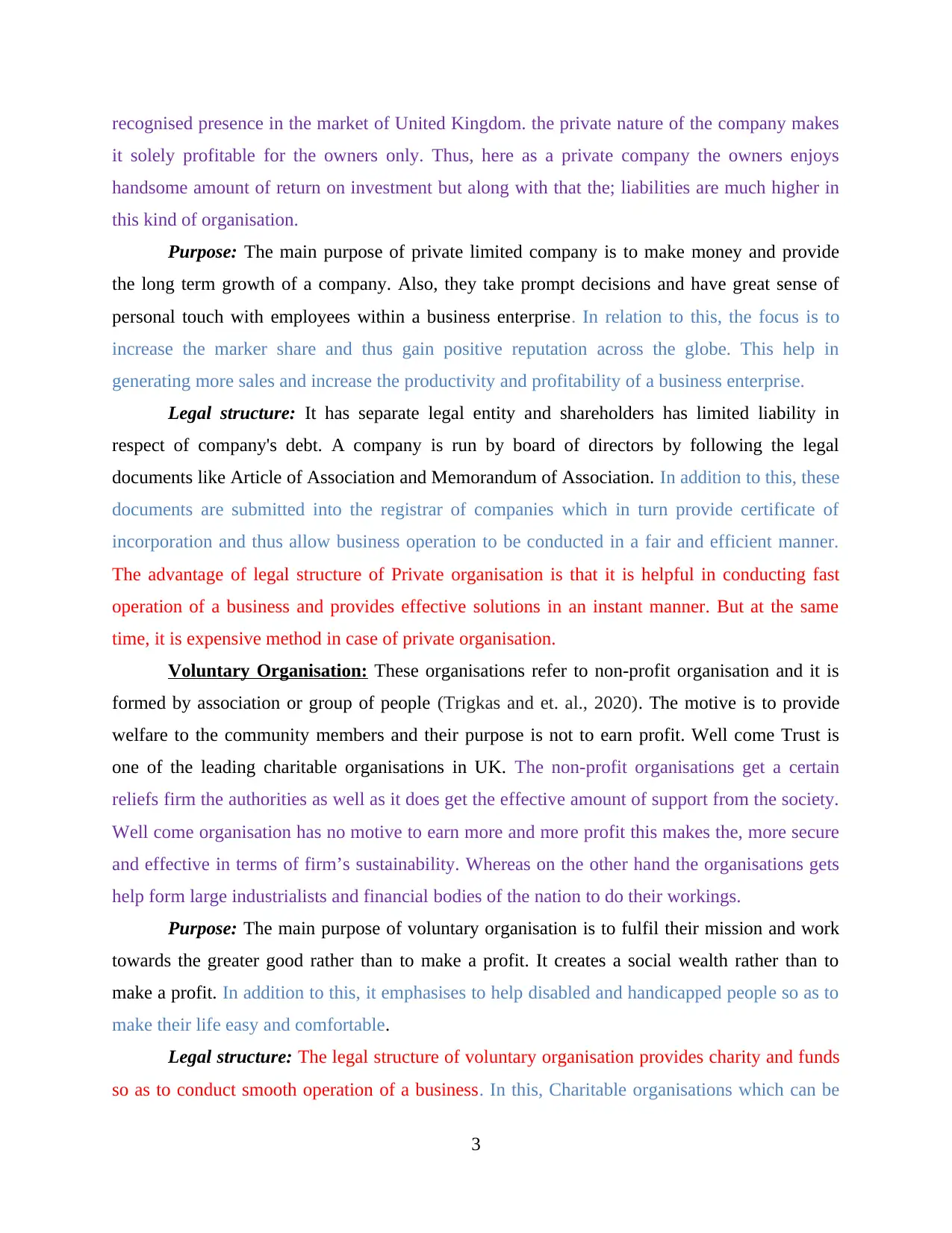
recognised presence in the market of United Kingdom. the private nature of the company makes
it solely profitable for the owners only. Thus, here as a private company the owners enjoys
handsome amount of return on investment but along with that the; liabilities are much higher in
this kind of organisation.
Purpose: The main purpose of private limited company is to make money and provide
the long term growth of a company. Also, they take prompt decisions and have great sense of
personal touch with employees within a business enterprise. In relation to this, the focus is to
increase the marker share and thus gain positive reputation across the globe. This help in
generating more sales and increase the productivity and profitability of a business enterprise.
Legal structure: It has separate legal entity and shareholders has limited liability in
respect of company's debt. A company is run by board of directors by following the legal
documents like Article of Association and Memorandum of Association. In addition to this, these
documents are submitted into the registrar of companies which in turn provide certificate of
incorporation and thus allow business operation to be conducted in a fair and efficient manner.
The advantage of legal structure of Private organisation is that it is helpful in conducting fast
operation of a business and provides effective solutions in an instant manner. But at the same
time, it is expensive method in case of private organisation.
Voluntary Organisation: These organisations refer to non-profit organisation and it is
formed by association or group of people (Trigkas and et. al., 2020). The motive is to provide
welfare to the community members and their purpose is not to earn profit. Well come Trust is
one of the leading charitable organisations in UK. The non-profit organisations get a certain
reliefs firm the authorities as well as it does get the effective amount of support from the society.
Well come organisation has no motive to earn more and more profit this makes the, more secure
and effective in terms of firm’s sustainability. Whereas on the other hand the organisations gets
help form large industrialists and financial bodies of the nation to do their workings.
Purpose: The main purpose of voluntary organisation is to fulfil their mission and work
towards the greater good rather than to make a profit. It creates a social wealth rather than to
make a profit. In addition to this, it emphasises to help disabled and handicapped people so as to
make their life easy and comfortable.
Legal structure: The legal structure of voluntary organisation provides charity and funds
so as to conduct smooth operation of a business. In this, Charitable organisations which can be
3
it solely profitable for the owners only. Thus, here as a private company the owners enjoys
handsome amount of return on investment but along with that the; liabilities are much higher in
this kind of organisation.
Purpose: The main purpose of private limited company is to make money and provide
the long term growth of a company. Also, they take prompt decisions and have great sense of
personal touch with employees within a business enterprise. In relation to this, the focus is to
increase the marker share and thus gain positive reputation across the globe. This help in
generating more sales and increase the productivity and profitability of a business enterprise.
Legal structure: It has separate legal entity and shareholders has limited liability in
respect of company's debt. A company is run by board of directors by following the legal
documents like Article of Association and Memorandum of Association. In addition to this, these
documents are submitted into the registrar of companies which in turn provide certificate of
incorporation and thus allow business operation to be conducted in a fair and efficient manner.
The advantage of legal structure of Private organisation is that it is helpful in conducting fast
operation of a business and provides effective solutions in an instant manner. But at the same
time, it is expensive method in case of private organisation.
Voluntary Organisation: These organisations refer to non-profit organisation and it is
formed by association or group of people (Trigkas and et. al., 2020). The motive is to provide
welfare to the community members and their purpose is not to earn profit. Well come Trust is
one of the leading charitable organisations in UK. The non-profit organisations get a certain
reliefs firm the authorities as well as it does get the effective amount of support from the society.
Well come organisation has no motive to earn more and more profit this makes the, more secure
and effective in terms of firm’s sustainability. Whereas on the other hand the organisations gets
help form large industrialists and financial bodies of the nation to do their workings.
Purpose: The main purpose of voluntary organisation is to fulfil their mission and work
towards the greater good rather than to make a profit. It creates a social wealth rather than to
make a profit. In addition to this, it emphasises to help disabled and handicapped people so as to
make their life easy and comfortable.
Legal structure: The legal structure of voluntary organisation provides charity and funds
so as to conduct smooth operation of a business. In this, Charitable organisations which can be
3
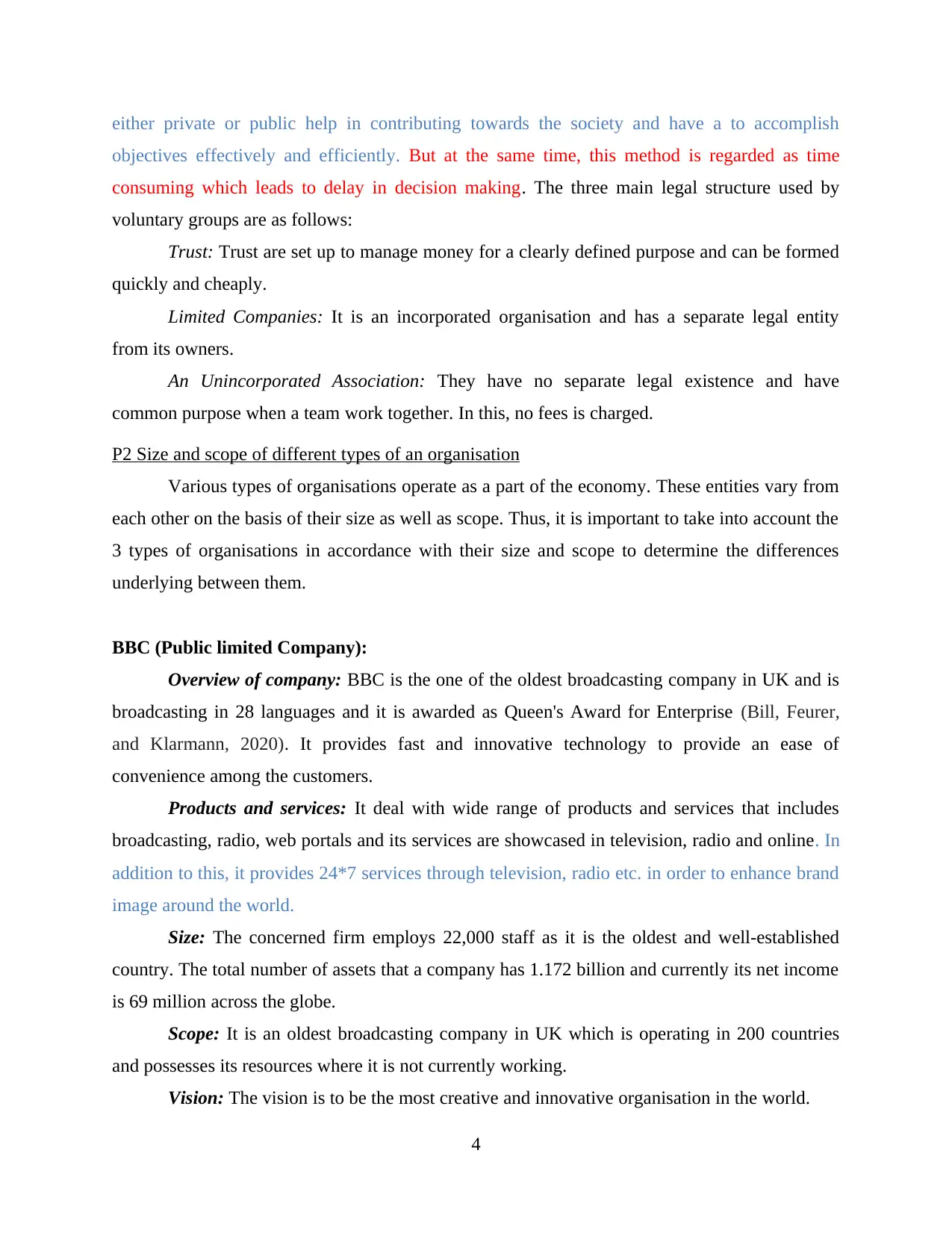
either private or public help in contributing towards the society and have a to accomplish
objectives effectively and efficiently. But at the same time, this method is regarded as time
consuming which leads to delay in decision making. The three main legal structure used by
voluntary groups are as follows:
Trust: Trust are set up to manage money for a clearly defined purpose and can be formed
quickly and cheaply.
Limited Companies: It is an incorporated organisation and has a separate legal entity
from its owners.
An Unincorporated Association: They have no separate legal existence and have
common purpose when a team work together. In this, no fees is charged.
P2 Size and scope of different types of an organisation
Various types of organisations operate as a part of the economy. These entities vary from
each other on the basis of their size as well as scope. Thus, it is important to take into account the
3 types of organisations in accordance with their size and scope to determine the differences
underlying between them.
BBC (Public limited Company):
Overview of company: BBC is the one of the oldest broadcasting company in UK and is
broadcasting in 28 languages and it is awarded as Queen's Award for Enterprise (Bill, Feurer,
and Klarmann, 2020). It provides fast and innovative technology to provide an ease of
convenience among the customers.
Products and services: It deal with wide range of products and services that includes
broadcasting, radio, web portals and its services are showcased in television, radio and online. In
addition to this, it provides 24*7 services through television, radio etc. in order to enhance brand
image around the world.
Size: The concerned firm employs 22,000 staff as it is the oldest and well-established
country. The total number of assets that a company has 1.172 billion and currently its net income
is 69 million across the globe.
Scope: It is an oldest broadcasting company in UK which is operating in 200 countries
and possesses its resources where it is not currently working.
Vision: The vision is to be the most creative and innovative organisation in the world.
4
objectives effectively and efficiently. But at the same time, this method is regarded as time
consuming which leads to delay in decision making. The three main legal structure used by
voluntary groups are as follows:
Trust: Trust are set up to manage money for a clearly defined purpose and can be formed
quickly and cheaply.
Limited Companies: It is an incorporated organisation and has a separate legal entity
from its owners.
An Unincorporated Association: They have no separate legal existence and have
common purpose when a team work together. In this, no fees is charged.
P2 Size and scope of different types of an organisation
Various types of organisations operate as a part of the economy. These entities vary from
each other on the basis of their size as well as scope. Thus, it is important to take into account the
3 types of organisations in accordance with their size and scope to determine the differences
underlying between them.
BBC (Public limited Company):
Overview of company: BBC is the one of the oldest broadcasting company in UK and is
broadcasting in 28 languages and it is awarded as Queen's Award for Enterprise (Bill, Feurer,
and Klarmann, 2020). It provides fast and innovative technology to provide an ease of
convenience among the customers.
Products and services: It deal with wide range of products and services that includes
broadcasting, radio, web portals and its services are showcased in television, radio and online. In
addition to this, it provides 24*7 services through television, radio etc. in order to enhance brand
image around the world.
Size: The concerned firm employs 22,000 staff as it is the oldest and well-established
country. The total number of assets that a company has 1.172 billion and currently its net income
is 69 million across the globe.
Scope: It is an oldest broadcasting company in UK which is operating in 200 countries
and possesses its resources where it is not currently working.
Vision: The vision is to be the most creative and innovative organisation in the world.
4
⊘ This is a preview!⊘
Do you want full access?
Subscribe today to unlock all pages.

Trusted by 1+ million students worldwide
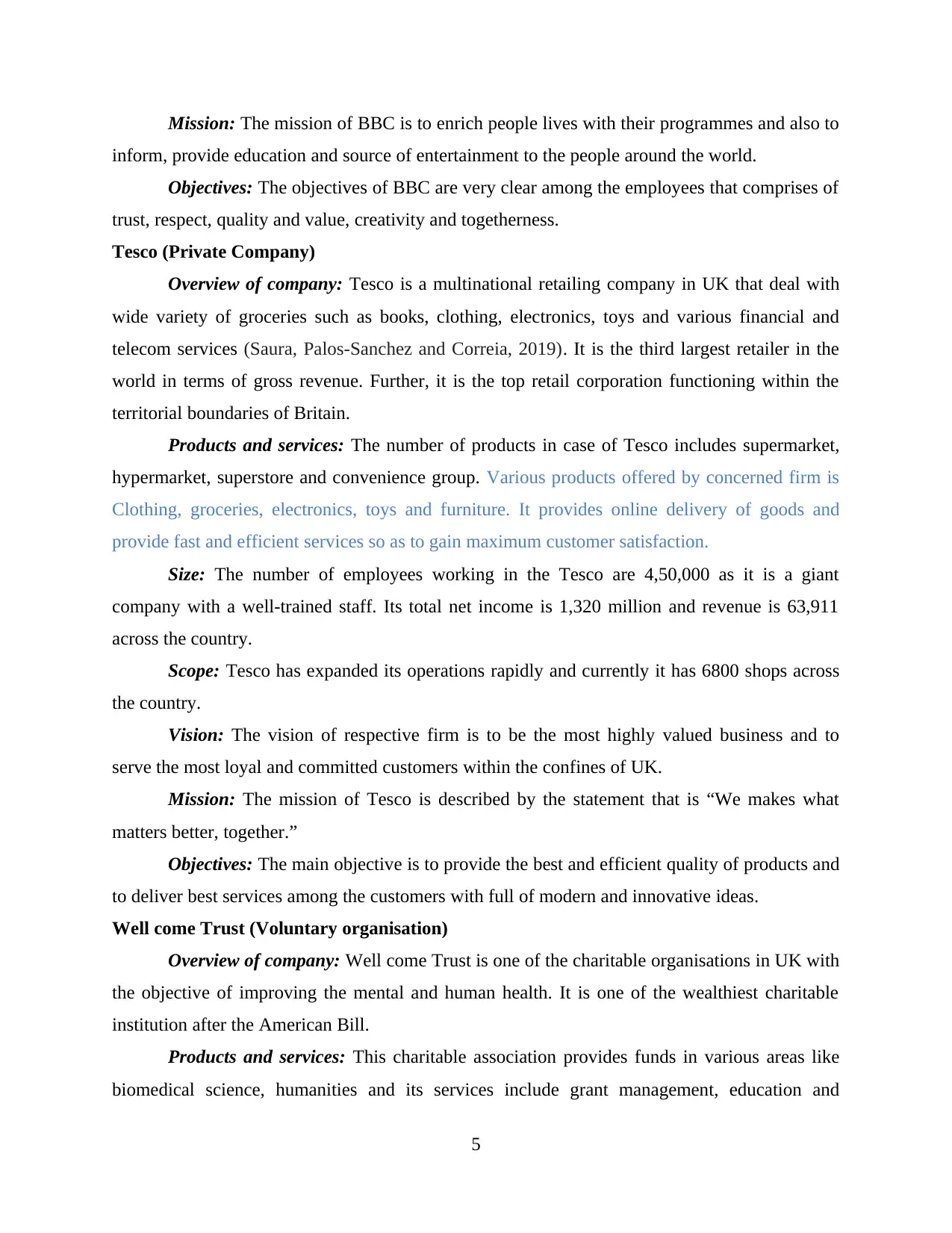
Mission: The mission of BBC is to enrich people lives with their programmes and also to
inform, provide education and source of entertainment to the people around the world.
Objectives: The objectives of BBC are very clear among the employees that comprises of
trust, respect, quality and value, creativity and togetherness.
Tesco (Private Company)
Overview of company: Tesco is a multinational retailing company in UK that deal with
wide variety of groceries such as books, clothing, electronics, toys and various financial and
telecom services (Saura, Palos-Sanchez and Correia, 2019). It is the third largest retailer in the
world in terms of gross revenue. Further, it is the top retail corporation functioning within the
territorial boundaries of Britain.
Products and services: The number of products in case of Tesco includes supermarket,
hypermarket, superstore and convenience group. Various products offered by concerned firm is
Clothing, groceries, electronics, toys and furniture. It provides online delivery of goods and
provide fast and efficient services so as to gain maximum customer satisfaction.
Size: The number of employees working in the Tesco are 4,50,000 as it is a giant
company with a well-trained staff. Its total net income is 1,320 million and revenue is 63,911
across the country.
Scope: Tesco has expanded its operations rapidly and currently it has 6800 shops across
the country.
Vision: The vision of respective firm is to be the most highly valued business and to
serve the most loyal and committed customers within the confines of UK.
Mission: The mission of Tesco is described by the statement that is “We makes what
matters better, together.”
Objectives: The main objective is to provide the best and efficient quality of products and
to deliver best services among the customers with full of modern and innovative ideas.
Well come Trust (Voluntary organisation)
Overview of company: Well come Trust is one of the charitable organisations in UK with
the objective of improving the mental and human health. It is one of the wealthiest charitable
institution after the American Bill.
Products and services: This charitable association provides funds in various areas like
biomedical science, humanities and its services include grant management, education and
5
inform, provide education and source of entertainment to the people around the world.
Objectives: The objectives of BBC are very clear among the employees that comprises of
trust, respect, quality and value, creativity and togetherness.
Tesco (Private Company)
Overview of company: Tesco is a multinational retailing company in UK that deal with
wide variety of groceries such as books, clothing, electronics, toys and various financial and
telecom services (Saura, Palos-Sanchez and Correia, 2019). It is the third largest retailer in the
world in terms of gross revenue. Further, it is the top retail corporation functioning within the
territorial boundaries of Britain.
Products and services: The number of products in case of Tesco includes supermarket,
hypermarket, superstore and convenience group. Various products offered by concerned firm is
Clothing, groceries, electronics, toys and furniture. It provides online delivery of goods and
provide fast and efficient services so as to gain maximum customer satisfaction.
Size: The number of employees working in the Tesco are 4,50,000 as it is a giant
company with a well-trained staff. Its total net income is 1,320 million and revenue is 63,911
across the country.
Scope: Tesco has expanded its operations rapidly and currently it has 6800 shops across
the country.
Vision: The vision of respective firm is to be the most highly valued business and to
serve the most loyal and committed customers within the confines of UK.
Mission: The mission of Tesco is described by the statement that is “We makes what
matters better, together.”
Objectives: The main objective is to provide the best and efficient quality of products and
to deliver best services among the customers with full of modern and innovative ideas.
Well come Trust (Voluntary organisation)
Overview of company: Well come Trust is one of the charitable organisations in UK with
the objective of improving the mental and human health. It is one of the wealthiest charitable
institution after the American Bill.
Products and services: This charitable association provides funds in various areas like
biomedical science, humanities and its services include grant management, education and
5
Paraphrase This Document
Need a fresh take? Get an instant paraphrase of this document with our AI Paraphraser
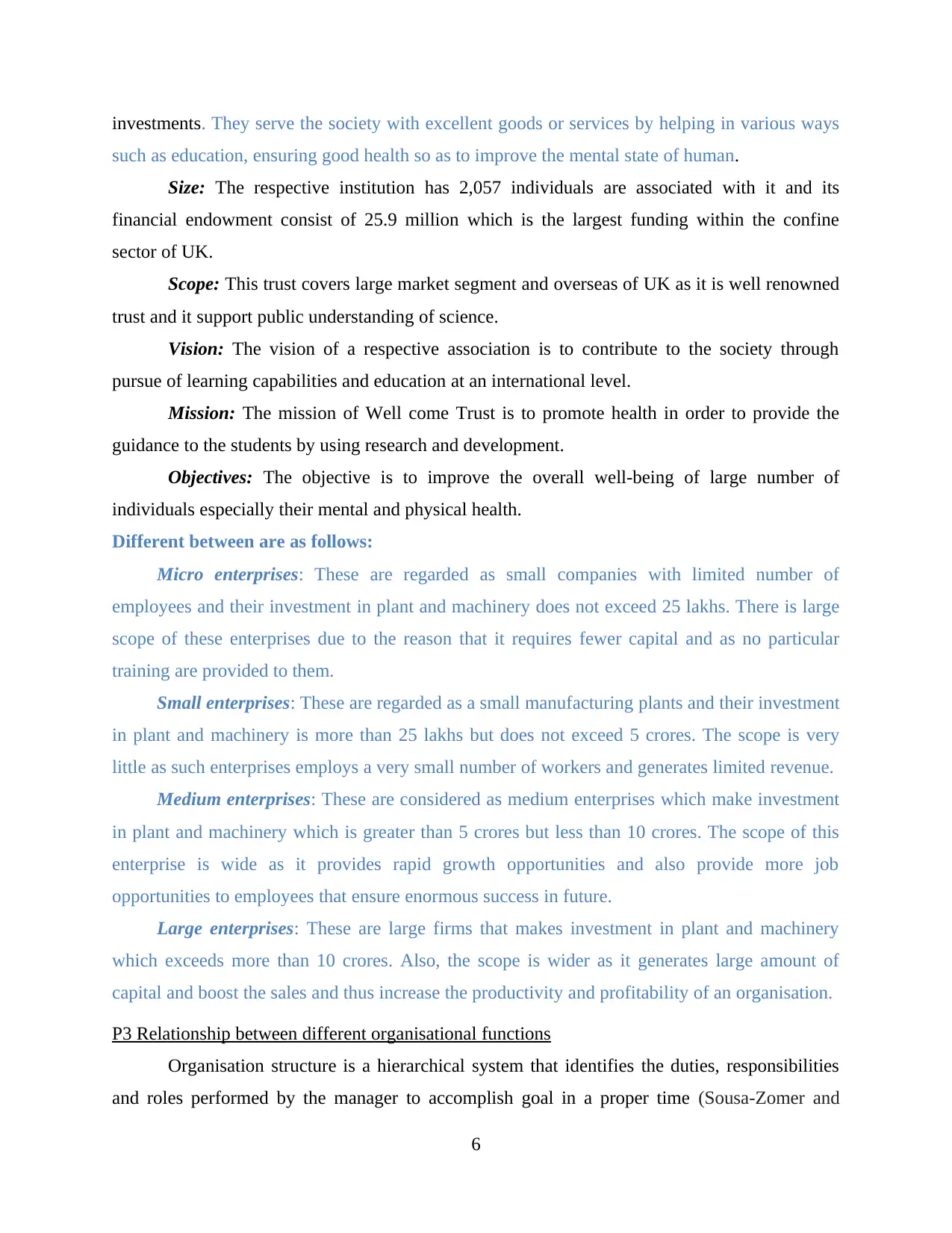
investments. They serve the society with excellent goods or services by helping in various ways
such as education, ensuring good health so as to improve the mental state of human.
Size: The respective institution has 2,057 individuals are associated with it and its
financial endowment consist of 25.9 million which is the largest funding within the confine
sector of UK.
Scope: This trust covers large market segment and overseas of UK as it is well renowned
trust and it support public understanding of science.
Vision: The vision of a respective association is to contribute to the society through
pursue of learning capabilities and education at an international level.
Mission: The mission of Well come Trust is to promote health in order to provide the
guidance to the students by using research and development.
Objectives: The objective is to improve the overall well-being of large number of
individuals especially their mental and physical health.
Different between are as follows:
Micro enterprises: These are regarded as small companies with limited number of
employees and their investment in plant and machinery does not exceed 25 lakhs. There is large
scope of these enterprises due to the reason that it requires fewer capital and as no particular
training are provided to them.
Small enterprises: These are regarded as a small manufacturing plants and their investment
in plant and machinery is more than 25 lakhs but does not exceed 5 crores. The scope is very
little as such enterprises employs a very small number of workers and generates limited revenue.
Medium enterprises: These are considered as medium enterprises which make investment
in plant and machinery which is greater than 5 crores but less than 10 crores. The scope of this
enterprise is wide as it provides rapid growth opportunities and also provide more job
opportunities to employees that ensure enormous success in future.
Large enterprises: These are large firms that makes investment in plant and machinery
which exceeds more than 10 crores. Also, the scope is wider as it generates large amount of
capital and boost the sales and thus increase the productivity and profitability of an organisation.
P3 Relationship between different organisational functions
Organisation structure is a hierarchical system that identifies the duties, responsibilities
and roles performed by the manager to accomplish goal in a proper time (Sousa-Zomer and
6
such as education, ensuring good health so as to improve the mental state of human.
Size: The respective institution has 2,057 individuals are associated with it and its
financial endowment consist of 25.9 million which is the largest funding within the confine
sector of UK.
Scope: This trust covers large market segment and overseas of UK as it is well renowned
trust and it support public understanding of science.
Vision: The vision of a respective association is to contribute to the society through
pursue of learning capabilities and education at an international level.
Mission: The mission of Well come Trust is to promote health in order to provide the
guidance to the students by using research and development.
Objectives: The objective is to improve the overall well-being of large number of
individuals especially their mental and physical health.
Different between are as follows:
Micro enterprises: These are regarded as small companies with limited number of
employees and their investment in plant and machinery does not exceed 25 lakhs. There is large
scope of these enterprises due to the reason that it requires fewer capital and as no particular
training are provided to them.
Small enterprises: These are regarded as a small manufacturing plants and their investment
in plant and machinery is more than 25 lakhs but does not exceed 5 crores. The scope is very
little as such enterprises employs a very small number of workers and generates limited revenue.
Medium enterprises: These are considered as medium enterprises which make investment
in plant and machinery which is greater than 5 crores but less than 10 crores. The scope of this
enterprise is wide as it provides rapid growth opportunities and also provide more job
opportunities to employees that ensure enormous success in future.
Large enterprises: These are large firms that makes investment in plant and machinery
which exceeds more than 10 crores. Also, the scope is wider as it generates large amount of
capital and boost the sales and thus increase the productivity and profitability of an organisation.
P3 Relationship between different organisational functions
Organisation structure is a hierarchical system that identifies the duties, responsibilities
and roles performed by the manager to accomplish goal in a proper time (Sousa-Zomer and
6
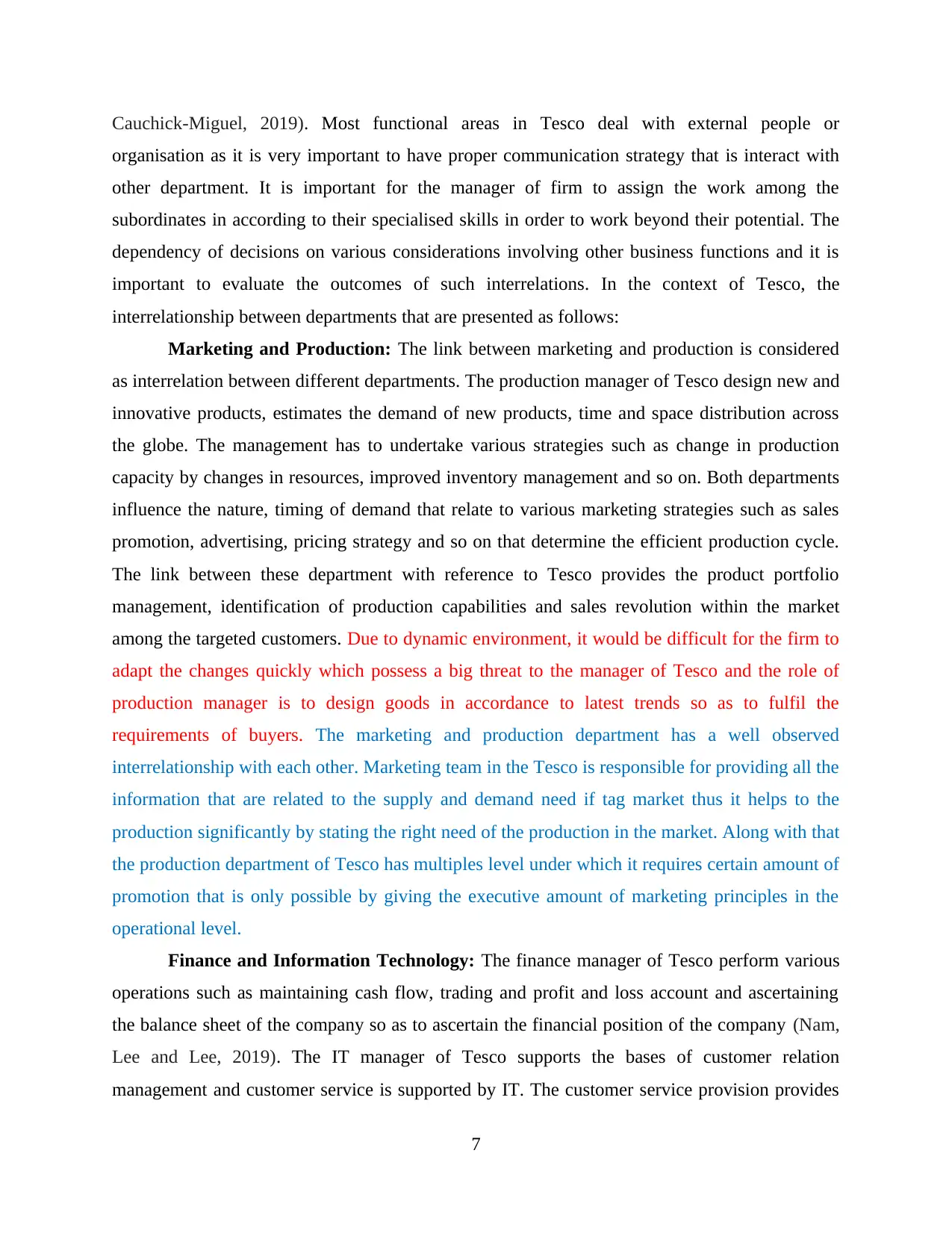
Cauchick-Miguel, 2019). Most functional areas in Tesco deal with external people or
organisation as it is very important to have proper communication strategy that is interact with
other department. It is important for the manager of firm to assign the work among the
subordinates in according to their specialised skills in order to work beyond their potential. The
dependency of decisions on various considerations involving other business functions and it is
important to evaluate the outcomes of such interrelations. In the context of Tesco, the
interrelationship between departments that are presented as follows:
Marketing and Production: The link between marketing and production is considered
as interrelation between different departments. The production manager of Tesco design new and
innovative products, estimates the demand of new products, time and space distribution across
the globe. The management has to undertake various strategies such as change in production
capacity by changes in resources, improved inventory management and so on. Both departments
influence the nature, timing of demand that relate to various marketing strategies such as sales
promotion, advertising, pricing strategy and so on that determine the efficient production cycle.
The link between these department with reference to Tesco provides the product portfolio
management, identification of production capabilities and sales revolution within the market
among the targeted customers. Due to dynamic environment, it would be difficult for the firm to
adapt the changes quickly which possess a big threat to the manager of Tesco and the role of
production manager is to design goods in accordance to latest trends so as to fulfil the
requirements of buyers. The marketing and production department has a well observed
interrelationship with each other. Marketing team in the Tesco is responsible for providing all the
information that are related to the supply and demand need if tag market thus it helps to the
production significantly by stating the right need of the production in the market. Along with that
the production department of Tesco has multiples level under which it requires certain amount of
promotion that is only possible by giving the executive amount of marketing principles in the
operational level.
Finance and Information Technology: The finance manager of Tesco perform various
operations such as maintaining cash flow, trading and profit and loss account and ascertaining
the balance sheet of the company so as to ascertain the financial position of the company (Nam,
Lee and Lee, 2019). The IT manager of Tesco supports the bases of customer relation
management and customer service is supported by IT. The customer service provision provides
7
organisation as it is very important to have proper communication strategy that is interact with
other department. It is important for the manager of firm to assign the work among the
subordinates in according to their specialised skills in order to work beyond their potential. The
dependency of decisions on various considerations involving other business functions and it is
important to evaluate the outcomes of such interrelations. In the context of Tesco, the
interrelationship between departments that are presented as follows:
Marketing and Production: The link between marketing and production is considered
as interrelation between different departments. The production manager of Tesco design new and
innovative products, estimates the demand of new products, time and space distribution across
the globe. The management has to undertake various strategies such as change in production
capacity by changes in resources, improved inventory management and so on. Both departments
influence the nature, timing of demand that relate to various marketing strategies such as sales
promotion, advertising, pricing strategy and so on that determine the efficient production cycle.
The link between these department with reference to Tesco provides the product portfolio
management, identification of production capabilities and sales revolution within the market
among the targeted customers. Due to dynamic environment, it would be difficult for the firm to
adapt the changes quickly which possess a big threat to the manager of Tesco and the role of
production manager is to design goods in accordance to latest trends so as to fulfil the
requirements of buyers. The marketing and production department has a well observed
interrelationship with each other. Marketing team in the Tesco is responsible for providing all the
information that are related to the supply and demand need if tag market thus it helps to the
production significantly by stating the right need of the production in the market. Along with that
the production department of Tesco has multiples level under which it requires certain amount of
promotion that is only possible by giving the executive amount of marketing principles in the
operational level.
Finance and Information Technology: The finance manager of Tesco perform various
operations such as maintaining cash flow, trading and profit and loss account and ascertaining
the balance sheet of the company so as to ascertain the financial position of the company (Nam,
Lee and Lee, 2019). The IT manager of Tesco supports the bases of customer relation
management and customer service is supported by IT. The customer service provision provides
7
⊘ This is a preview!⊘
Do you want full access?
Subscribe today to unlock all pages.

Trusted by 1+ million students worldwide
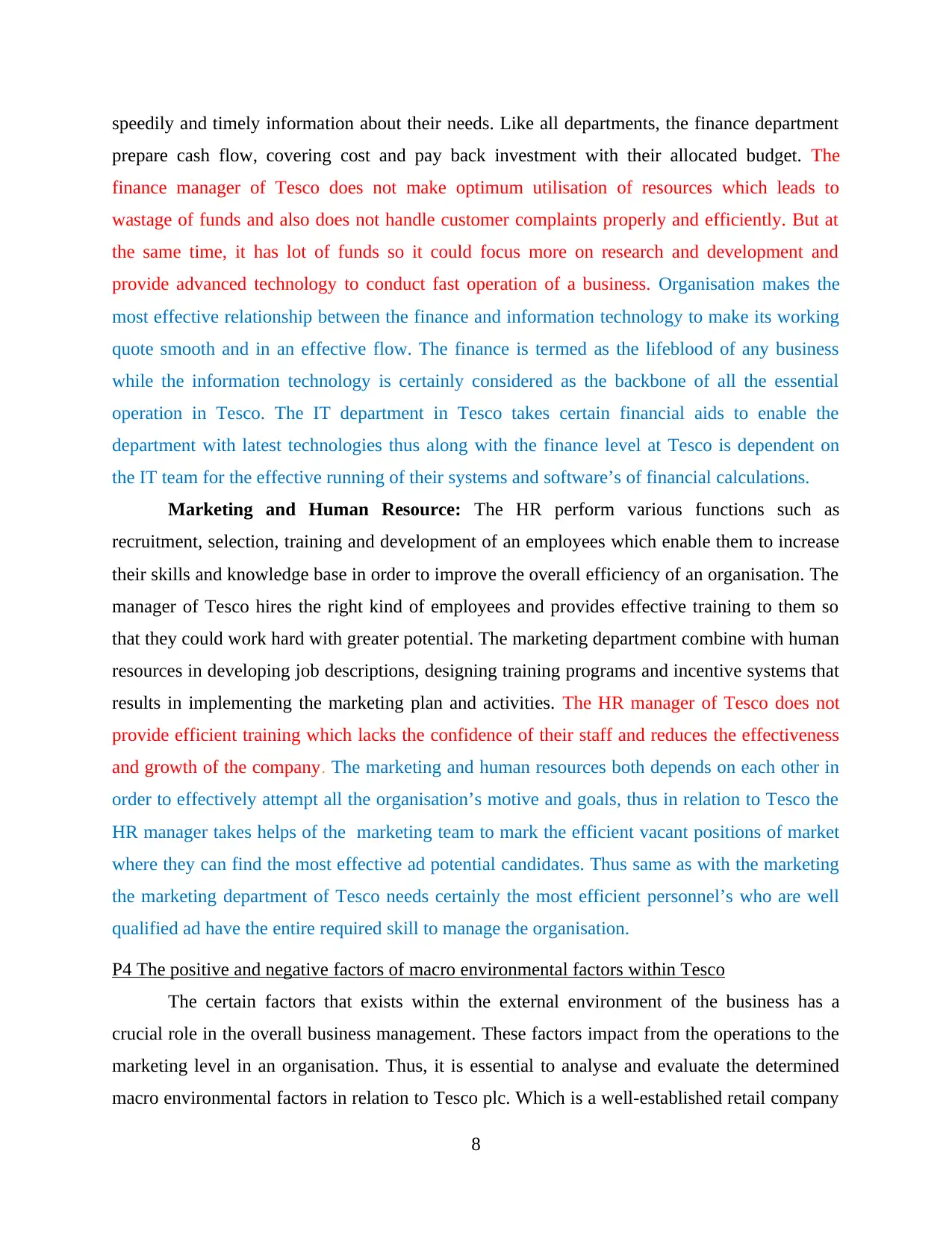
speedily and timely information about their needs. Like all departments, the finance department
prepare cash flow, covering cost and pay back investment with their allocated budget. The
finance manager of Tesco does not make optimum utilisation of resources which leads to
wastage of funds and also does not handle customer complaints properly and efficiently. But at
the same time, it has lot of funds so it could focus more on research and development and
provide advanced technology to conduct fast operation of a business. Organisation makes the
most effective relationship between the finance and information technology to make its working
quote smooth and in an effective flow. The finance is termed as the lifeblood of any business
while the information technology is certainly considered as the backbone of all the essential
operation in Tesco. The IT department in Tesco takes certain financial aids to enable the
department with latest technologies thus along with the finance level at Tesco is dependent on
the IT team for the effective running of their systems and software’s of financial calculations.
Marketing and Human Resource: The HR perform various functions such as
recruitment, selection, training and development of an employees which enable them to increase
their skills and knowledge base in order to improve the overall efficiency of an organisation. The
manager of Tesco hires the right kind of employees and provides effective training to them so
that they could work hard with greater potential. The marketing department combine with human
resources in developing job descriptions, designing training programs and incentive systems that
results in implementing the marketing plan and activities. The HR manager of Tesco does not
provide efficient training which lacks the confidence of their staff and reduces the effectiveness
and growth of the company. The marketing and human resources both depends on each other in
order to effectively attempt all the organisation’s motive and goals, thus in relation to Tesco the
HR manager takes helps of the marketing team to mark the efficient vacant positions of market
where they can find the most effective ad potential candidates. Thus same as with the marketing
the marketing department of Tesco needs certainly the most efficient personnel’s who are well
qualified ad have the entire required skill to manage the organisation.
P4 The positive and negative factors of macro environmental factors within Tesco
The certain factors that exists within the external environment of the business has a
crucial role in the overall business management. These factors impact from the operations to the
marketing level in an organisation. Thus, it is essential to analyse and evaluate the determined
macro environmental factors in relation to Tesco plc. Which is a well-established retail company
8
prepare cash flow, covering cost and pay back investment with their allocated budget. The
finance manager of Tesco does not make optimum utilisation of resources which leads to
wastage of funds and also does not handle customer complaints properly and efficiently. But at
the same time, it has lot of funds so it could focus more on research and development and
provide advanced technology to conduct fast operation of a business. Organisation makes the
most effective relationship between the finance and information technology to make its working
quote smooth and in an effective flow. The finance is termed as the lifeblood of any business
while the information technology is certainly considered as the backbone of all the essential
operation in Tesco. The IT department in Tesco takes certain financial aids to enable the
department with latest technologies thus along with the finance level at Tesco is dependent on
the IT team for the effective running of their systems and software’s of financial calculations.
Marketing and Human Resource: The HR perform various functions such as
recruitment, selection, training and development of an employees which enable them to increase
their skills and knowledge base in order to improve the overall efficiency of an organisation. The
manager of Tesco hires the right kind of employees and provides effective training to them so
that they could work hard with greater potential. The marketing department combine with human
resources in developing job descriptions, designing training programs and incentive systems that
results in implementing the marketing plan and activities. The HR manager of Tesco does not
provide efficient training which lacks the confidence of their staff and reduces the effectiveness
and growth of the company. The marketing and human resources both depends on each other in
order to effectively attempt all the organisation’s motive and goals, thus in relation to Tesco the
HR manager takes helps of the marketing team to mark the efficient vacant positions of market
where they can find the most effective ad potential candidates. Thus same as with the marketing
the marketing department of Tesco needs certainly the most efficient personnel’s who are well
qualified ad have the entire required skill to manage the organisation.
P4 The positive and negative factors of macro environmental factors within Tesco
The certain factors that exists within the external environment of the business has a
crucial role in the overall business management. These factors impact from the operations to the
marketing level in an organisation. Thus, it is essential to analyse and evaluate the determined
macro environmental factors in relation to Tesco plc. Which is a well-established retail company
8
Paraphrase This Document
Need a fresh take? Get an instant paraphrase of this document with our AI Paraphraser
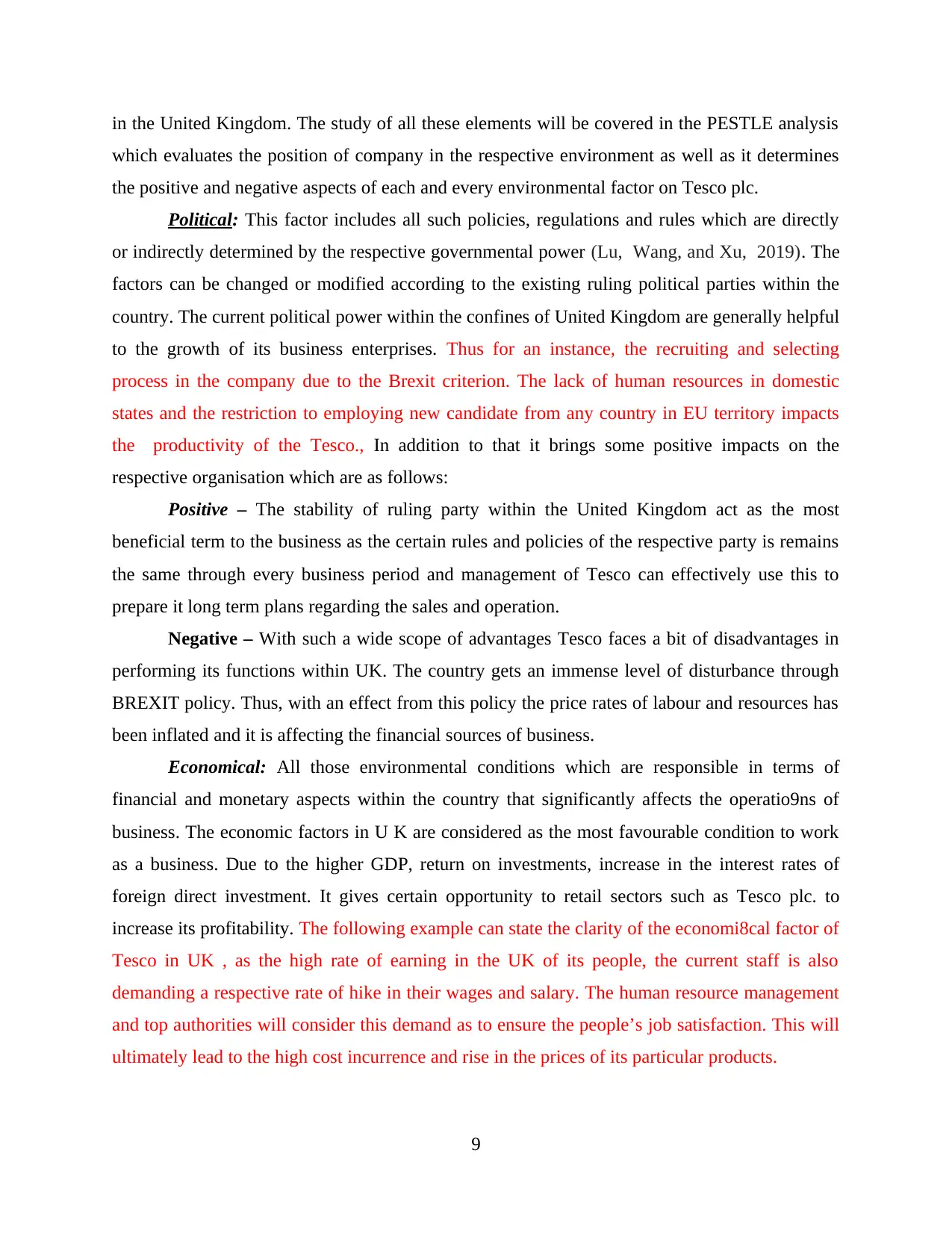
in the United Kingdom. The study of all these elements will be covered in the PESTLE analysis
which evaluates the position of company in the respective environment as well as it determines
the positive and negative aspects of each and every environmental factor on Tesco plc.
Political: This factor includes all such policies, regulations and rules which are directly
or indirectly determined by the respective governmental power (Lu, Wang, and Xu, 2019). The
factors can be changed or modified according to the existing ruling political parties within the
country. The current political power within the confines of United Kingdom are generally helpful
to the growth of its business enterprises. Thus for an instance, the recruiting and selecting
process in the company due to the Brexit criterion. The lack of human resources in domestic
states and the restriction to employing new candidate from any country in EU territory impacts
the productivity of the Tesco., In addition to that it brings some positive impacts on the
respective organisation which are as follows:
Positive – The stability of ruling party within the United Kingdom act as the most
beneficial term to the business as the certain rules and policies of the respective party is remains
the same through every business period and management of Tesco can effectively use this to
prepare it long term plans regarding the sales and operation.
Negative – With such a wide scope of advantages Tesco faces a bit of disadvantages in
performing its functions within UK. The country gets an immense level of disturbance through
BREXIT policy. Thus, with an effect from this policy the price rates of labour and resources has
been inflated and it is affecting the financial sources of business.
Economical: All those environmental conditions which are responsible in terms of
financial and monetary aspects within the country that significantly affects the operatio9ns of
business. The economic factors in U K are considered as the most favourable condition to work
as a business. Due to the higher GDP, return on investments, increase in the interest rates of
foreign direct investment. It gives certain opportunity to retail sectors such as Tesco plc. to
increase its profitability. The following example can state the clarity of the economi8cal factor of
Tesco in UK , as the high rate of earning in the UK of its people, the current staff is also
demanding a respective rate of hike in their wages and salary. The human resource management
and top authorities will consider this demand as to ensure the people’s job satisfaction. This will
ultimately lead to the high cost incurrence and rise in the prices of its particular products.
9
which evaluates the position of company in the respective environment as well as it determines
the positive and negative aspects of each and every environmental factor on Tesco plc.
Political: This factor includes all such policies, regulations and rules which are directly
or indirectly determined by the respective governmental power (Lu, Wang, and Xu, 2019). The
factors can be changed or modified according to the existing ruling political parties within the
country. The current political power within the confines of United Kingdom are generally helpful
to the growth of its business enterprises. Thus for an instance, the recruiting and selecting
process in the company due to the Brexit criterion. The lack of human resources in domestic
states and the restriction to employing new candidate from any country in EU territory impacts
the productivity of the Tesco., In addition to that it brings some positive impacts on the
respective organisation which are as follows:
Positive – The stability of ruling party within the United Kingdom act as the most
beneficial term to the business as the certain rules and policies of the respective party is remains
the same through every business period and management of Tesco can effectively use this to
prepare it long term plans regarding the sales and operation.
Negative – With such a wide scope of advantages Tesco faces a bit of disadvantages in
performing its functions within UK. The country gets an immense level of disturbance through
BREXIT policy. Thus, with an effect from this policy the price rates of labour and resources has
been inflated and it is affecting the financial sources of business.
Economical: All those environmental conditions which are responsible in terms of
financial and monetary aspects within the country that significantly affects the operatio9ns of
business. The economic factors in U K are considered as the most favourable condition to work
as a business. Due to the higher GDP, return on investments, increase in the interest rates of
foreign direct investment. It gives certain opportunity to retail sectors such as Tesco plc. to
increase its profitability. The following example can state the clarity of the economi8cal factor of
Tesco in UK , as the high rate of earning in the UK of its people, the current staff is also
demanding a respective rate of hike in their wages and salary. The human resource management
and top authorities will consider this demand as to ensure the people’s job satisfaction. This will
ultimately lead to the high cost incurrence and rise in the prices of its particular products.
9
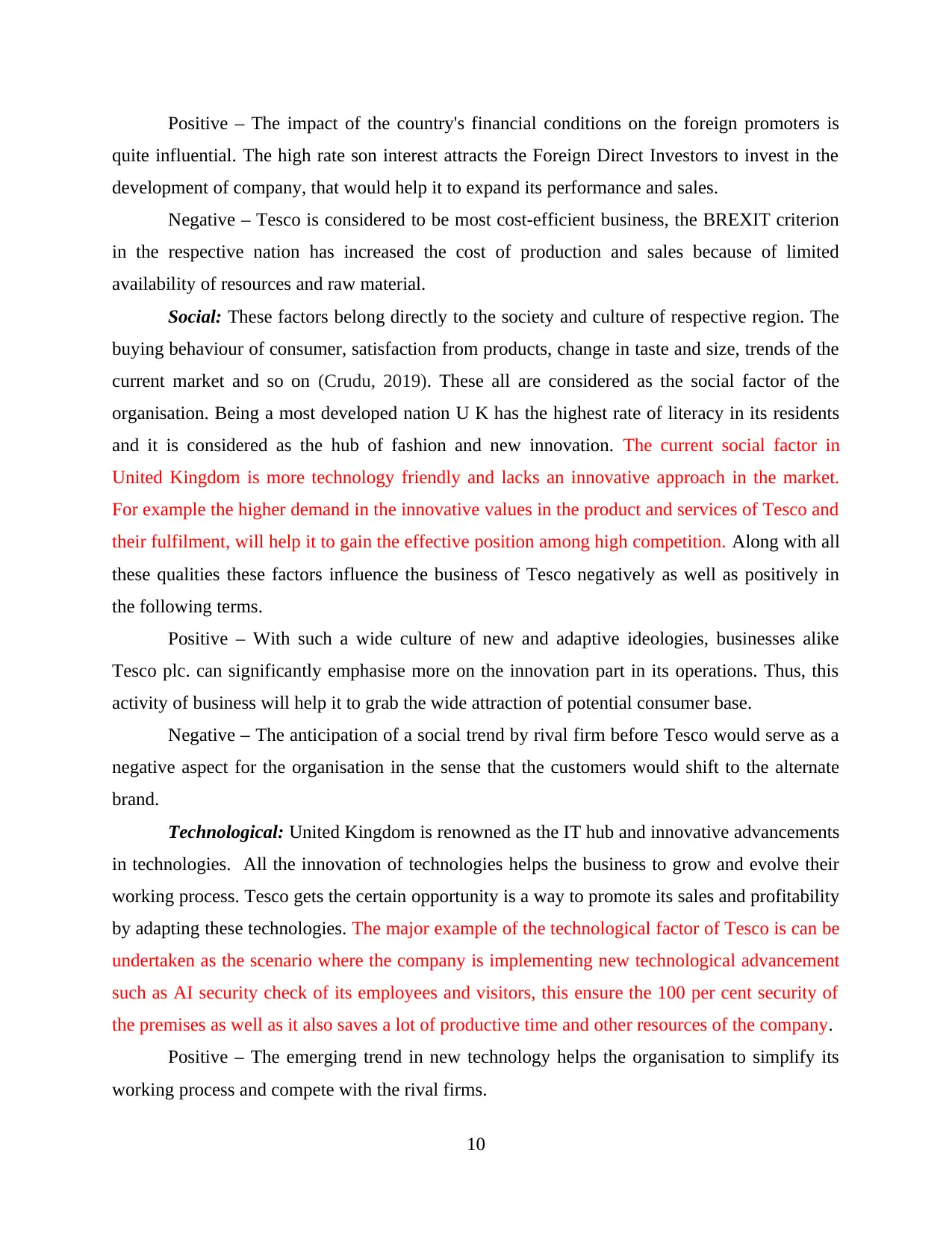
Positive – The impact of the country's financial conditions on the foreign promoters is
quite influential. The high rate son interest attracts the Foreign Direct Investors to invest in the
development of company, that would help it to expand its performance and sales.
Negative – Tesco is considered to be most cost-efficient business, the BREXIT criterion
in the respective nation has increased the cost of production and sales because of limited
availability of resources and raw material.
Social: These factors belong directly to the society and culture of respective region. The
buying behaviour of consumer, satisfaction from products, change in taste and size, trends of the
current market and so on (Crudu, 2019). These all are considered as the social factor of the
organisation. Being a most developed nation U K has the highest rate of literacy in its residents
and it is considered as the hub of fashion and new innovation. The current social factor in
United Kingdom is more technology friendly and lacks an innovative approach in the market.
For example the higher demand in the innovative values in the product and services of Tesco and
their fulfilment, will help it to gain the effective position among high competition. Along with all
these qualities these factors influence the business of Tesco negatively as well as positively in
the following terms.
Positive – With such a wide culture of new and adaptive ideologies, businesses alike
Tesco plc. can significantly emphasise more on the innovation part in its operations. Thus, this
activity of business will help it to grab the wide attraction of potential consumer base.
Negative – The anticipation of a social trend by rival firm before Tesco would serve as a
negative aspect for the organisation in the sense that the customers would shift to the alternate
brand.
Technological: United Kingdom is renowned as the IT hub and innovative advancements
in technologies. All the innovation of technologies helps the business to grow and evolve their
working process. Tesco gets the certain opportunity is a way to promote its sales and profitability
by adapting these technologies. The major example of the technological factor of Tesco is can be
undertaken as the scenario where the company is implementing new technological advancement
such as AI security check of its employees and visitors, this ensure the 100 per cent security of
the premises as well as it also saves a lot of productive time and other resources of the company.
Positive – The emerging trend in new technology helps the organisation to simplify its
working process and compete with the rival firms.
10
quite influential. The high rate son interest attracts the Foreign Direct Investors to invest in the
development of company, that would help it to expand its performance and sales.
Negative – Tesco is considered to be most cost-efficient business, the BREXIT criterion
in the respective nation has increased the cost of production and sales because of limited
availability of resources and raw material.
Social: These factors belong directly to the society and culture of respective region. The
buying behaviour of consumer, satisfaction from products, change in taste and size, trends of the
current market and so on (Crudu, 2019). These all are considered as the social factor of the
organisation. Being a most developed nation U K has the highest rate of literacy in its residents
and it is considered as the hub of fashion and new innovation. The current social factor in
United Kingdom is more technology friendly and lacks an innovative approach in the market.
For example the higher demand in the innovative values in the product and services of Tesco and
their fulfilment, will help it to gain the effective position among high competition. Along with all
these qualities these factors influence the business of Tesco negatively as well as positively in
the following terms.
Positive – With such a wide culture of new and adaptive ideologies, businesses alike
Tesco plc. can significantly emphasise more on the innovation part in its operations. Thus, this
activity of business will help it to grab the wide attraction of potential consumer base.
Negative – The anticipation of a social trend by rival firm before Tesco would serve as a
negative aspect for the organisation in the sense that the customers would shift to the alternate
brand.
Technological: United Kingdom is renowned as the IT hub and innovative advancements
in technologies. All the innovation of technologies helps the business to grow and evolve their
working process. Tesco gets the certain opportunity is a way to promote its sales and profitability
by adapting these technologies. The major example of the technological factor of Tesco is can be
undertaken as the scenario where the company is implementing new technological advancement
such as AI security check of its employees and visitors, this ensure the 100 per cent security of
the premises as well as it also saves a lot of productive time and other resources of the company.
Positive – The emerging trend in new technology helps the organisation to simplify its
working process and compete with the rival firms.
10
⊘ This is a preview!⊘
Do you want full access?
Subscribe today to unlock all pages.

Trusted by 1+ million students worldwide
1 out of 19
Related Documents
Your All-in-One AI-Powered Toolkit for Academic Success.
+13062052269
info@desklib.com
Available 24*7 on WhatsApp / Email
![[object Object]](/_next/static/media/star-bottom.7253800d.svg)
Unlock your academic potential
Copyright © 2020–2025 A2Z Services. All Rights Reserved. Developed and managed by ZUCOL.




